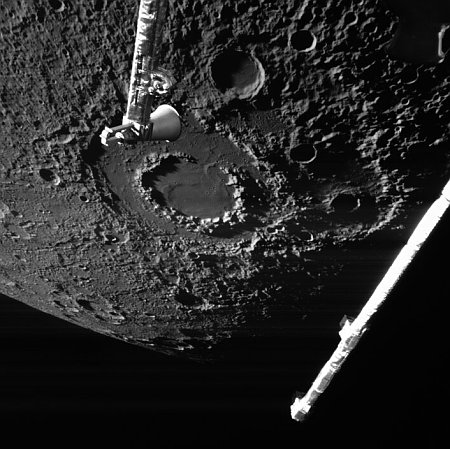ESA releases images taken by BepiColombo during Mercury fly-by
The European Space Agency (ESA) yesterday released images taken by the BepiColombo probe as it completed its fourth fly-by of Mercury on its long journey to enter orbit around that planet.
The picture to the right, cropped, reduced, and sharpened to post here, was taken four minutes after the closest approach of about 103 miles.
Four minutes after closest approach, a large ‘peak ring basin’ came into BepiColombo’s view. These mysterious craters – created by powerful asteroid or comet impacts and measuring about 130–330 km across – are called peak rings basins after the inner ring of peaks on an otherwise flattish floor.
This large crater is Vivaldi, after the famous Italian composer Antonio Vivaldi (1678–1741). It measures 210 km across, and because BepiColombo saw it so close to the sunrise line, its landscape is beautifully emphasised by shadow. There is a visible gap in the ring of peaks, where more recent lava flows have entered and flooded the crater.
BepiColombo still has two more fly-bys of Mercury to do before entering orbit in November 2026. At that time the spacecraft’s two orbiters, one from Europe and the other from Japan, will separate and take up complementary orbits.
On Christmas Eve 1968 three Americans became the first humans to visit another world. What they did to celebrate was unexpected and profound, and will be remembered throughout all human history. Genesis: the Story of Apollo 8, Robert Zimmerman's classic history of humanity's first journey to another world, tells that story, and it is now available as both an ebook and an audiobook, both with a foreword by Valerie Anders and a new introduction by Robert Zimmerman.
The print edition can be purchased at Amazon or from any other book seller. If you want an autographed copy the price is $60 for the hardback and $45 for the paperback, plus $8 shipping for each. Go here for purchasing details. The ebook is available everywhere for $5.99 (before discount) at amazon, or direct from my ebook publisher, ebookit. If you buy it from ebookit you don't support the big tech companies and the author gets a bigger cut much sooner.
The audiobook is also available at all these vendors, and is also free with a 30-day trial membership to Audible.
"Not simply about one mission, [Genesis] is also the history of America's quest for the moon... Zimmerman has done a masterful job of tying disparate events together into a solid account of one of America's greatest human triumphs."--San Antonio Express-News
The European Space Agency (ESA) yesterday released images taken by the BepiColombo probe as it completed its fourth fly-by of Mercury on its long journey to enter orbit around that planet.
The picture to the right, cropped, reduced, and sharpened to post here, was taken four minutes after the closest approach of about 103 miles.
Four minutes after closest approach, a large ‘peak ring basin’ came into BepiColombo’s view. These mysterious craters – created by powerful asteroid or comet impacts and measuring about 130–330 km across – are called peak rings basins after the inner ring of peaks on an otherwise flattish floor.
This large crater is Vivaldi, after the famous Italian composer Antonio Vivaldi (1678–1741). It measures 210 km across, and because BepiColombo saw it so close to the sunrise line, its landscape is beautifully emphasised by shadow. There is a visible gap in the ring of peaks, where more recent lava flows have entered and flooded the crater.
BepiColombo still has two more fly-bys of Mercury to do before entering orbit in November 2026. At that time the spacecraft’s two orbiters, one from Europe and the other from Japan, will separate and take up complementary orbits.
On Christmas Eve 1968 three Americans became the first humans to visit another world. What they did to celebrate was unexpected and profound, and will be remembered throughout all human history. Genesis: the Story of Apollo 8, Robert Zimmerman's classic history of humanity's first journey to another world, tells that story, and it is now available as both an ebook and an audiobook, both with a foreword by Valerie Anders and a new introduction by Robert Zimmerman.
The print edition can be purchased at Amazon or from any other book seller. If you want an autographed copy the price is $60 for the hardback and $45 for the paperback, plus $8 shipping for each. Go here for purchasing details. The ebook is available everywhere for $5.99 (before discount) at amazon, or direct from my ebook publisher, ebookit. If you buy it from ebookit you don't support the big tech companies and the author gets a bigger cut much sooner.
The audiobook is also available at all these vendors, and is also free with a 30-day trial membership to Audible.
"Not simply about one mission, [Genesis] is also the history of America's quest for the moon... Zimmerman has done a masterful job of tying disparate events together into a solid account of one of America's greatest human triumphs."--San Antonio Express-News



Although pretty pock-marked, there are regions in the picture that appear fairly crater free, and with what seems mountainous terrain, rather than smooth plains one would expect from volcanic events…
I admit to having almost no knowledge about Mercury, other than it is mostly metallic core, but given that it is at the bottom of our solar systems gravity well I would expect more craters.
Is the surface churned up by many, many small impacts, or is something else at work here? Any links or knowledge much appreciated!
Lee S: Um, why don’t do what I do to start, do a search on BtB for “Mercury.” In my posts I always link to my sources, so the data mine will be deep.